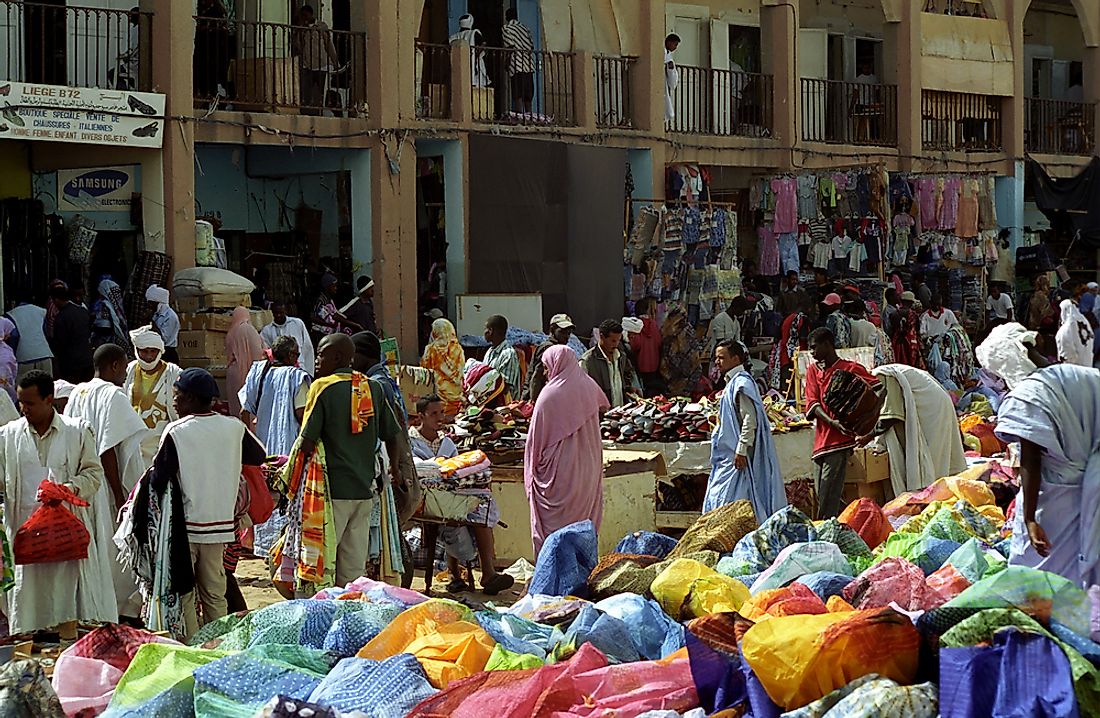What Is The Ethnic Composition Of Mauritania?

Mauritania is Africa’s 11th largest country and it is located in Northwest Africa. It is bordered to the west by the Atlantic Ocean, to the northeast by Algeria, Senegal to the southwest, and Mali to the southeast. About 90% of the country is in the Sahara. The population is mostly concentrated in the south. Mauritania has a population of approximately 4.3 million people. The country’s largest and capital city is Nouakchott, accounting for about one-third of the population. The majority of Mauritians are Muslims, adhering to the Sunni denominations. The official and national language of Mauritania is Arabic while French is widely used in media.
The population of Mauritania is subdivided into three major ethnic groups: Moor or Bidhan, West Africans, and Haratin. According to the Central Intelligence Agency (CIA) World Fact Book, the Bidhans account for approximately 30% of the population while the Haratins are 40%. However, the Bidhans account for 53% of the citizens. Although Arabic is the official and national language, other languages such as French, Soninke, Pulaar, Serer, and Wolof are also widely spoken. Here are the major ethnic groups in Mauritania.
Black Moors (Haratin)
The Haratins are oasis dwellers commonly found in the Sahara, particularly Mauritania where they are the ethnic majority. The group is also found in Western Sahara and Morocco. In Libya and Tunisia, Haratin are called Chouachin. This ethnic group accounts for about 40% of Mauritania’s total population and are sometimes referred to as the Black Moors to distinguish them from the Beidane or the White Moors. The Haratins in Mauritania are either former slaves or descendants of West African slaves and are Arabic-speakers. Some of the slaves were acquired by the Berbers in the 3rd century and others arrived after the Arabs. Most of them are related to ethnic groups such as Soninke, Fulani, Wolof, and Bambara people. The Haratin of Mauritania were part of a social cast-like hierarchy that may have developed from a Bedouin legacy around 1500 CE. The White Moors owned properties and held the Black Moors as slaves.
In 1960, slavery in Mauritania was abolished. However, the new laws still discriminated against Haratin. In 1994, Amnesty International reported that about 90,000 Haratins in Mauritania still lived as slaves, with reports suggesting that slavery was still widespread, especially within the traditional upper class of the Moors. However, the government of Mauritania insists that any relationship between the master and serf is mutually consensual.
White Moors (Bidhan/Sahrawi)
About 30% of the population of Mauritania is the Saharawi people. The Sahrawi inhabit mainly the western part of the Sahara Desert including countries such as Algeria, Western Sahara, Mauritania, and Morocco. The name Sahrawi is an Arabic word which literally translates to “inhabitants of the desert.” The regions where the ethnic group hails from were originally inhabited by the nomadic Berbers before the arrival of Islam in the 8th century CE. It was the Berbers who spread the new faith in the region. The Arabs began settling in the area in the 11th century and were slowly assimilated after several failed opposition from the Berber. The Berbers would eventually embrace the Arabs and their culture. Today, Hassaniya, an Arabic dialect, remains a mother tongue in Mauritania and has almost replaced the Berber languages originally spoken in the area. Thus, the modern Saharawi people in Mauritania are of Arab-Berber descent.
The ethnic group is divided into several groups of different social status. At the top is the Hassane (aristocratic warriors) who are the descendants of Beni Hassan Arab tribe. Below them are the Zawiya tribes (scholars) followed by the Znaga tribes (mainly fishermen). The Saharawi people are mainly Sunni Muslims.
Sub-Saharan Mauritanians
About 30% of the population of Mauritania belong to several other sub-Saharan ethnic groups. The majority are West Africans originating from the Senegal River. One such group are the Fulani people. The Fulani is one of the largest ethnic group in West Africa and Sahel, inhabiting several countries in the region. There are approximately 900,000 Fulani people in Mauritania, inhabiting mainly the southern region. The majority are pastoralists while Islam is the most popular religion among them.
There is also a small community of Haalpulaar in Mauritania, especially in the southern region. The Haalpulaar are native Futa Tooro region of Senegal but are also found in Mali. They speak the Pulaar language as their first language. In fact, they refer to themselves as “Haalpulaar’en” meaning “speakers of Pulaar.”
The Soninke people are also found in Southern Mauritania and other countries such as Senegal, Mali, and Guinea. They speak the Soninke language which is a member of the Mande languages. The Soninke people may have originated from the Dinga from the Middle East. However, other sources indicate that the group may have migrated from Aswan, Egypt.
The Wolof people are the largest ethnic group in Senegal but are a minority group in Gambia and Mauritania. There are approximately 230,000 of them in Mauritania, especially in the country’s coastal areas. Although their history is unclear, it is widely believed that they were forced to move to the east and north Senegal during the Arab conquest of West Africa. They would later spread into the Gambia and coastal Mauritania.
What Is The Ethnic Composition Of Mauritania?
| Rank | Major Ethnic Groups | % of total population |
|---|---|---|
| 1 | Black Moors (Haratines - Arab-speaking slaves, former slaves, and their descendants of African origin, enslaved by white Moors) | 40% |
| 2 | White Moors (of Arab-Berber descent, known as Beydane) | 30% |
| 3 | Sub-Saharan Mauritanians (non-Arabic speaking, largely resident in or originating from the Senegal River Valley, including Halpulaar, Fulani, Soninke, Wolof, and Bambara ethnic groups) | 30% |











